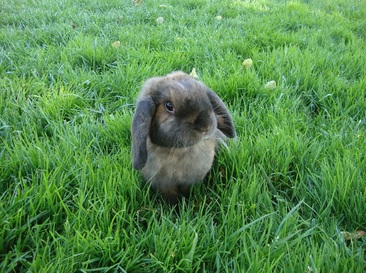Bonnie's Story
Our spokesbunny, Bonnie, fractured her spine on June 18, 2012 when she was just 11 months old. It happened in an overnight accident. We think she was either playing or got spooked by something and kicked her back legs too hard. The injury left her paralyzed in her hind legs. It has been a long, difficult road to recovery, but we did it and Bonnie is thriving despite her disability. Our hope with this page is to chronicle Bonnie's journey, from injury to health, to help those owners who may be facing similar situations with their own buns. We also hope this page will help to further share Bonnie's message: that a bunny can make it to recovery and thrive despite a disability.
Injury
On June 18th, at around 12:30am, we awoke to Bonnie screaming. We rushed to her pen to find her laying in her litter box, her legs out by her side. She was breathing very fast and her eyes were wide. We stepped into her pen to comfort her. We pet her head and talked to her soothingly. She didn’t respond. We tried to lift her gently, to see if she would “snap out of it” and hop away. We were stunned when she just laid there and let us pick her up. Bonnie hated being picked up and would never let us do so without some kind of wiggling. But that night: nothing. We brought her to our laps and felt her body; and then her legs. They just dangled there. There was no tension in them at all; they were just lifeless. We grabbed a blanket for her to lay on and rushed her to the emergency vet.
Injury
On June 18th, at around 12:30am, we awoke to Bonnie screaming. We rushed to her pen to find her laying in her litter box, her legs out by her side. She was breathing very fast and her eyes were wide. We stepped into her pen to comfort her. We pet her head and talked to her soothingly. She didn’t respond. We tried to lift her gently, to see if she would “snap out of it” and hop away. We were stunned when she just laid there and let us pick her up. Bonnie hated being picked up and would never let us do so without some kind of wiggling. But that night: nothing. We brought her to our laps and felt her body; and then her legs. They just dangled there. There was no tension in them at all; they were just lifeless. We grabbed a blanket for her to lay on and rushed her to the emergency vet.
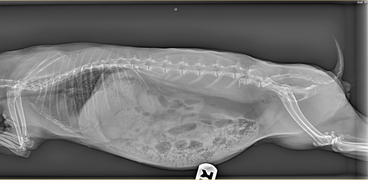
They took her in right away. The vet gave her an injectable anti-inflammatory and pain medication. Then they took x-rays. When we finally got to talk to the doctor, she didn’t give us good news. Bonnie had severed her spine and the injury had paralyzed her in her hind legs. The vet told us that there really wasn’t anything she could do. She explained that Bonnie’s chances of ever hopping again were practically zero. She said that without the use of her hind legs, her quality of life would be poor. We should do the kind thing and put her to sleep.
We were devastated, but determined that this wasn’t going to be the end for our little girl. We had no idea what to expect nor any clue how we were going to care for a partially paralyzed disabled rabbit, but we were committed to her through thick and thin. Later that morning, we picked her up and brought her home. The vet advised us to keep her confined so her spine could heal and sent us home with pain medication to give her twice a day. The next evening, we brought her to her regular vet. While he was also discouraged by her x-rays, he supported our decision to give Bonnie a chance. He told us that the next 6 weeks or so would be crucial as far as her healing. He insisted that she stay confined as much as possible and talked with us about how important it was to make sure she was eating, drinking, eliminating and staying clean. The rest, though, was really up to us to figure out.
Recovery
Recovery
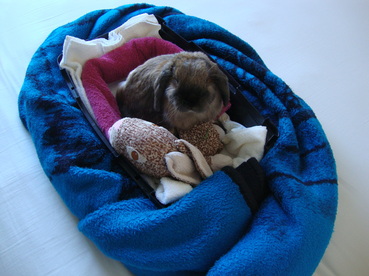
For the first few days, we kept Bonnie housed in her carrier. She has one of those hard plastic carriers with the removable top. We took the top off and lined the bottom with a cotton towel with puppy pads underneath. Then we rolled up a smaller towel to encircle her with and keep her snug and supported. We fed her often, as much as she would eat, and brought a small water dish to her so she could drink. We lifted her very gently about every two hours or so to change the towel, puppy pad and clear away any poos. We tried to handle her as little as possible. When she did need to be handled, we cradled her on her back in our arms and tried to put as little pressure as possible on her lower back. We gave her bottom baths by dipping her hind end into a tub of warm water. We let her soak and used our hand to work through the fur on her underside and wash away any urine. Then we dried her with microfiber towels and a few minutes with the blow dryer. Then she was tucked back into her carrier for rest. She had someone with her at all times. At night, she slept between us on our bed. We put the door and lid on at night and wrapped the carrier with a big blanket so it wouldn't wobble around.
After a week or so in the carrier, she started to perk up a bit. The initial shock and pain seemed to subside somewhat (or at least became more manageable) and she started showing some interest in things like food and pets. At that point, we purchased a “rabbit cage” from the pet store (one of the ones with the plastic bottoms and the white lids that clip on top). We lined the bottom again with towels on top of puppy pads. We lined the sides with rolled towels for her to lean against and added a stuffed animal for her to snuggle with. For a short time every day, we would fold a washcloth and tuck it underneath her belly to reduce the downward pressure of her spine. She really seemed to like this. With the slightly larger area, she was able to have pellets and hay available for her to nibble on as she wished. She still struggled with her water dish, so we would offer it to her every hour or so. We did find that it took her a good while for her to gain her footing. For the first week or two, she laid with her chest against her bedding and her front legs splayed out to the side. To help with this, we added an additional rolled towel to each of her sides to help support her legs. She also struggled maintaining her weight. At her highest before her injury, she weighed 5.90lbs. At her lowest afterwards she weighed 3.81lbs. To help combat the loss, we supplemented her diet with Critical Care mixed with pumpkin/apple baby food and a little bit of whole rolled oats. Thankfully, she kept her love for food and we really bonded during feeding times. We would sit with her often throughout the day to keep her company and moved her cage here and there so she could stay a part of the family goings on.
After a week or so in the carrier, she started to perk up a bit. The initial shock and pain seemed to subside somewhat (or at least became more manageable) and she started showing some interest in things like food and pets. At that point, we purchased a “rabbit cage” from the pet store (one of the ones with the plastic bottoms and the white lids that clip on top). We lined the bottom again with towels on top of puppy pads. We lined the sides with rolled towels for her to lean against and added a stuffed animal for her to snuggle with. For a short time every day, we would fold a washcloth and tuck it underneath her belly to reduce the downward pressure of her spine. She really seemed to like this. With the slightly larger area, she was able to have pellets and hay available for her to nibble on as she wished. She still struggled with her water dish, so we would offer it to her every hour or so. We did find that it took her a good while for her to gain her footing. For the first week or two, she laid with her chest against her bedding and her front legs splayed out to the side. To help with this, we added an additional rolled towel to each of her sides to help support her legs. She also struggled maintaining her weight. At her highest before her injury, she weighed 5.90lbs. At her lowest afterwards she weighed 3.81lbs. To help combat the loss, we supplemented her diet with Critical Care mixed with pumpkin/apple baby food and a little bit of whole rolled oats. Thankfully, she kept her love for food and we really bonded during feeding times. We would sit with her often throughout the day to keep her company and moved her cage here and there so she could stay a part of the family goings on.
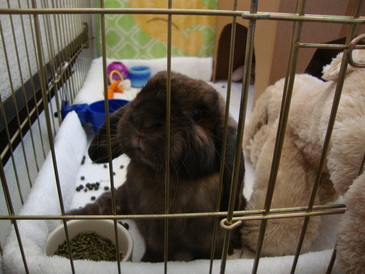
After about 6 weeks of more confined "bed rest," we moved Bonnie into a converted x-pen setup. We lined the bottom with bath rugs, then a washable puppy pad, a layer of cotton towels and finally a top layer of sherpa fabric (we talk more about our bedding setup on our Bedding page). We lined the inside of the pen with rolled up towels (which we have since replaced with baby crib bumpers) to keep her legs from getting caught in the bars. She got a large cardboard box with the sides cut out for a house and of course her stuffed animals to keep her company. We built a little trough to hold her hay since she couldn't reach a traditional hay rack and we worried about it getting soiled if we left it on the floor. Then, of course, her easily accessible food and water dishes, miscellaneous toys and a fleece blanket to cuddle with. She loved having more space and it encouraged her to be more active. Though she was still a bit clumsy and would fall or get stuck at times, she learned her footing and became stronger as time went on. It was at this point that we also started taking her out of her pen for short periods. We set up a puppy pad in the living room and let her scoot about. It gave her a much-wanted feeling of freedom and did a lot to boost her mood.
Physical Therapy
Physical Therapy
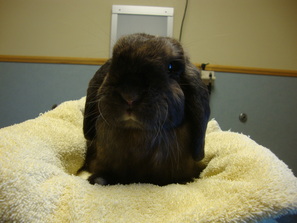
In September, about three months after her injury, Bonnie had a final checkup with her vet. He reevaluated her spine, did follow-up x-rays and proclaimed her as healed as she was going to get. The spine itself had re-fused, was sturdy, and we could finally take the next step and start her on physical therapy. She began her first physical therapy appointment on September 19, 2012. She did acupuncture, laser therapy, veterinary orthopedic manipulation (or VOM; basically chiropractics for bunnies), and she had aquapunture injections to her back. We started this treatment once a week, then did it every other week, then every two weeks. She had her last physical therapy appointment on December 11, 2012. Through these therapies, we noticed a significant improvement in her overall strength, stamina and nerve response. She gained more feeling in her toes and she became better able to use her back right leg, which has been instrumental in her being able to be somewhat mobile.
Healed
Between her initial recovery period, healing and physical therapy, it was about 6 months after her injury when we officially declared Bonnie completely healed. Her spine was solid, we could handle her without too much worry, she could play without restriction, she was maintaining her weight and was, overall, stable and healthy.
Summary
Learning to care for a disabled rabbit was not easy. From the start, the biggest issues we faced were:
We have come a very long way since we first embarked on our journey caring for a disabled rabbit and we have learned a ton along the way. We hope that what we've learned can help other owners who are going through what we've gone through. We hope it can give hope to owners who are just starting out and help those who are already caring for a bun do so better. Specifics about the things we learned and what we recommend for disabled rabbit care can be found throughout this website. We hope they help you.
Healed
Between her initial recovery period, healing and physical therapy, it was about 6 months after her injury when we officially declared Bonnie completely healed. Her spine was solid, we could handle her without too much worry, she could play without restriction, she was maintaining her weight and was, overall, stable and healthy.
Summary
Learning to care for a disabled rabbit was not easy. From the start, the biggest issues we faced were:
- Keeping her still. Bonnie has always been an "on the go" type of bun. It was hard to keep her from moving and to keep her confined, especially in the beginning. Naturally, she got restless. But, confinement was very important to her recovery. When she was in her carrier, we tried to keep her in a relatively normal resting position with her legs tucked under her. We did our best to keep her in that position and limit her activity throughout her initial healing period by petting her, engaging her and encouraging her to rest. We do think this played a key role in her spine healing as successfully as it did.
- Keeping her clean. It took a long time to develop a cleaning routine that was effective. When we first started giving Bonnie bottom baths, it took hours and we never felt like her fur and skin got really clean. We would give her a bath and still her skin would have crusted on urine and her fur would be matted. When we started using zymox shampoo, the difference was like night and day. It worked through all the crust and mess, left her skin soothed and, finally, we saw some of that fluffy fur grow back in. Since we mastered a "system," we can now do a full bottom bath from start to finish in 10-15 minutes.
- Keeping her dry. Bonnie lost control of her bladder when she injured her spine and would dribble as the need arose- which was often. Because she couldn't lift herself with her back legs, her bottom end was often pressed against her bedding. When the bedding got wet with urine, it stayed pressed against her keeping her wet. So, naturally, some urine scald developed. We went through trial and error with lots of different bedding setups and finally found sherpa fabric, which has been wonderful at wicking away urine. Learning how to express her bladder manually has made an incredible difference as well. We express her bladder a few times a day and that, in combination with proper bedding, helps her stay dry and she no longer struggles with urine scald.
- Keeping her fed. It is natural for a disabled rabbit to lose some weight due to muscle atrophy, especially when a condition affects the back legs. Bonnie lost a worrisome amount of weight after her injury despite a healthy appetite. Critical Care was a life saver. She loves it mixed with organic baby food and it helps keep her at a healthy weight even today.
- Keeping her happy. With her activity limited and her being unable to enjoy normal bunny activities (hopping, playing, digging), it's understandable that Bonnie would need a little extra help when it comes to staying busy. We try to keep her entertained with lots of interaction from her humans, "smart toys" that encourage her to work for treats, adapted bunny activities (she still loves to dig, so we give her a small fleece blanket to work on), play time outside in the fresh air and lots and lots of snuggles. She is still a fairly active, curious bunny despite her disabilities and we are so glad that we have been able to help her keep that happy attitude.
We have come a very long way since we first embarked on our journey caring for a disabled rabbit and we have learned a ton along the way. We hope that what we've learned can help other owners who are going through what we've gone through. We hope it can give hope to owners who are just starting out and help those who are already caring for a bun do so better. Specifics about the things we learned and what we recommend for disabled rabbit care can be found throughout this website. We hope they help you.
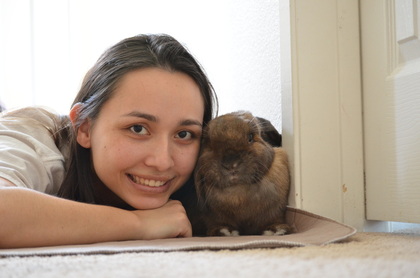
Final Thoughts
Our experience with Bonnie's injury and recovery was a challenging, but truly rewarding one. We had a lot to learn and, we won't lie, it was difficult. It was heartbreaking to see our once healthy, vibrant, active young bun reduced to a tiny cage where she was slumped on her stomach looking miserable much of the time. But, there were glimpses of her old self. She soaked up pets and begged for food and showed interest in what was around her. So, we held out hope and pressed on. As the days and weeks went by, things improved greatly. She was noticeably feeling better, seemed more alert and interested in moving around. Now, writing this a few years later, we are full of amazement when we think of how far she's come. Sure, it was hard. But we've never been more happy with a decision we've made, never more confident that we did the right thing. While we never would have wished this for her, we wouldn't change it either. We have grown immeasurably close as a family and have gained such a wonderful appreciation for what true bunny ownership is: commitment, care and a love that can overcome anything.
Our experience with Bonnie's injury and recovery was a challenging, but truly rewarding one. We had a lot to learn and, we won't lie, it was difficult. It was heartbreaking to see our once healthy, vibrant, active young bun reduced to a tiny cage where she was slumped on her stomach looking miserable much of the time. But, there were glimpses of her old self. She soaked up pets and begged for food and showed interest in what was around her. So, we held out hope and pressed on. As the days and weeks went by, things improved greatly. She was noticeably feeling better, seemed more alert and interested in moving around. Now, writing this a few years later, we are full of amazement when we think of how far she's come. Sure, it was hard. But we've never been more happy with a decision we've made, never more confident that we did the right thing. While we never would have wished this for her, we wouldn't change it either. We have grown immeasurably close as a family and have gained such a wonderful appreciation for what true bunny ownership is: commitment, care and a love that can overcome anything.

